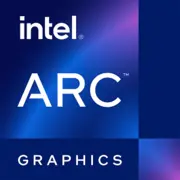Intel Arc A550M

Intel Arc A550M: A Powerful Player for Gamers and Professionals
April 2025
With the release of the Intel Arc lineup, the company has firmly established its position in the discrete GPU market. The Arc A550M graphics card, introduced in 2023, has undergone a series of optimizations over two years, making it a reliable choice for budget gaming laptops and compact PCs. Let's explore what attracts users and how it performs compared to its competitors.
1. Architecture and Key Features
Xe-HPG Architecture: The A550M is built on the Xe-HPG microarchitecture, designed specifically for gaming and professional tasks. The chip is manufactured using TSMC's 6nm process, ensuring a balance between energy efficiency and performance.
Unique Features:
- Ray Tracing (RT): Hardware support for ray tracing through Xe cores. Unlike NVIDIA's RTX 30 series, Intel's implementation is more modest— for example, in Cyberpunk 2077, enabling RT reduces FPS by 25-30%.
- XeSS (Xe Super Sampling): An alternative to DLSS and FSR. It uses AI algorithms to increase resolution with minimal quality loss. In games that support XeSS (such as Horizon Forbidden West), FPS gains can reach up to 40% in "Performance" mode.
- Compatibility with FidelityFX: Support for AMD technologies, including FSR 3.0, which expands the list of optimized projects.
2. Memory: Fast but Not Without Compromises
GDDR6 and Bandwidth: The A550M is equipped with 8 GB of GDDR6 memory on a 256-bit bus. The bandwidth is 384 GB/s (12 GHz frequency). This is sufficient for gaming at 1440p, but 4K gaming may suffer from stuttering due to limited VRAM capacity.
Impact on Performance: In tests for Call of Duty: Modern Warfare V (1440p, Ultra), the card uses 7.2 GB of memory, which is close to its limit. For professional tasks (like rendering in Blender), 8 GB is the minimum acceptable level, but it is sufficient for basic editing in DaVinci Resolve.
3. Gaming Performance: A Solid Mid-Range Performer
1080p:
- Apex Legends (Ultra): 110-120 FPS.
- Elden Ring (High, RT off): 75-85 FPS.
- Starfield (Medium): 60-70 FPS.
1440p:
- Average FPS drops by 25-35%. In Cyberpunk 2077 (High, RT off), for instance, it achieves around 45 FPS. With XeSS or FSR 3.0, stable 60 FPS can be attained.
4K:
- Only suitable for less demanding titles (CS2, Valorant) or with significantly reduced settings.
Ray Tracing: Activating RT in Control decreases FPS from 80 to 55 frames (1080p). It is recommended to combine RT with XeSS to compensate for performance loss.
4. Professional Tasks: Not Just for Gaming
Video Editing: In Premiere Pro, the A550M shows performance comparable to the NVIDIA RTX 3050 thanks to Intel Quick Sync support. Rendering a 10-minute 4K video takes about 8 minutes.
3D Modeling: In Blender (Cycles), the card lags behind CUDA-enabled alternatives but shows acceptable speed when using OpenCL—rendering a medium complexity scene takes about 12-15 minutes.
Scientific Calculations: Support for OpenCL and SYCL allows the GPU to be utilized for machine learning (TensorFlow), but for complex tasks, models with larger memory capacity are preferable.
5. Power Consumption and Thermal Output
TDP: 90 W. For laptops, this means active cooling systems are necessary, but in compact PC cases, the card remains cooler than AMD counterparts.
Recommendations:
- Cooling: At least two fans or liquid cooling in the PC. For laptops, choose models with ventilation openings on the back panel.
- Case: Good ventilation (for example, Fractal Design Meshify C) and a minimum of 3 case fans.
6. Comparison with Competitors
NVIDIA RTX 3050 Ti Mobile (8 GB):
- In gaming, the A550M is 10-15% faster due to its wider memory bus.
- RT performance is higher on NVIDIA, but the gap narrows with XeSS.
- Price: $349 (NVIDIA) vs. $299 (Intel).
AMD RX 6600M (8 GB):
- In DX12 projects, AMD wins by 5-7%, but in Vulkan (for example, Doom Eternal), the A550M catches up to the competitor.
- Both cards support FSR 3.0, but Intel's drivers are more stable (as of 2025).
7. Practical Tips
Power Supply: At least 450 W (for PCs). It’s better to choose models with an 80+ Bronze certification (Corsair CX450).
Compatibility:
- Requires PCIe 4.0 x8. Performance loss can be up to 5% on older platforms (PCIe 3.0).
- For laptops: Check system TDP— the A550M should not be installed in ultrabooks with passive cooling.
Drivers: Stability improved after the 2024 update. It is recommended to enable automatic updates through the Intel Driver & Support Assistant.
8. Pros and Cons
Pros:
- Price: $299 for a new card (April 2025).
- Support for XeSS and FSR 3.0.
- Good performance at 1080p and 1440p.
Cons:
- Limited memory capacity for 4K and professional tasks.
- RT performance is lower than NVIDIA's.
9. Final Verdict: Who is the Arc A550M For?
This graphics card is an ideal choice for:
- Gamers on a budget of up to $1000: Maximum quality at 1440p without overspending on a brand.
- Mobile users: Laptops based on the A550M are lighter and more affordable than those with RTX 3060.
- Content creators: Basic editing and 3D work without investing in professional GPUs.
The Intel Arc A550M demonstrates that even in 2025, you can achieve decent performance without a premium price tag. The key is to have a clear understanding of your tasks and not to expect miracles from ray tracing.
Basic
Memory Specifications
Theoretical Performance
Miscellaneous
Benchmarks
Compared to Other GPU
Related GPU Comparisons
Share in social media
Or Link To Us
<a href="https://cputronic.com/en/gpu/intel-arc-a550m" target="_blank">Intel Arc A550M</a>

